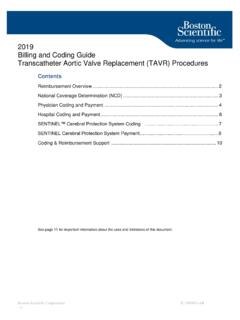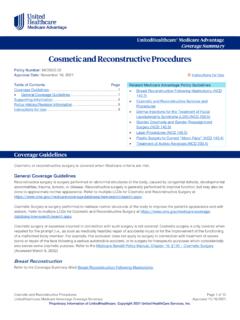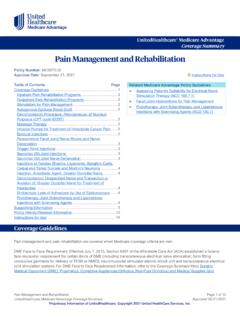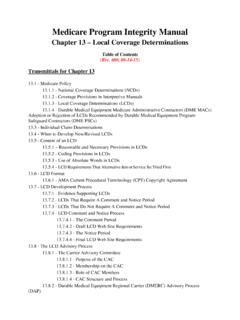Transcription of Local Coverage Determinations (LCDs) - CMS
1 MLN Matters MM10901 Related CR 10901. Local Coverage Determinations (LCDs). MLN Matters Number: MM10901 Revised Related Change Request (CR) Number: 10901. Related CR Release Date: February 12, 2019 Effective Date: October 3, 2018. Related CR Transmittal Number: R863PI Implementation Date: January 8, 2019. Note: We revised the article on February 14, 2019, to reflect the revised CR 10901 issued on February 12, 2019, that includes changes to the updates in Chapter 13 of the Medicare Program Integrity Manual. The CR changed the effective date to October 3, 2018, we made that change in the article. CMS also revised the CR release date, transmittal number, and the web address of the CR. All other information remains the same. PROVIDER TYPES AFFECTED. This MLN Matters Article is intended for physicians, providers, and suppliers billing Medicare Administrative Contractors (MACs) for services provided to Medicare beneficiaries. PROVIDER ACTION NEEDED.
2 CR 10901 notifies MACs that, in accordance with Section 4009 of 34-21st Century Cures Act (Public Law No: 114-255), the Centers for Medicare & Medicaid Services (CMS) is updating the Medicare Program Integrity Manual with detailed changes to the LCD process. You should ensure that your staffs are aware of these changes. BACKGROUND. Through feedback received in the proposed Calendar Year (CY) 2018 Physician Fee Schedule (PFS) Rule (82 FR 33950), and through meetings and correspondence; stakeholders, including providers and health care associations, have provided CMS with valuable insight regarding modernization of the LCD process. Most stakeholders acknowledged that the Local Coverage process is an important means to provide decisions related to the items and services that benefit Medicare's beneficiaries and to ensure beneficiary access to life saving and medically necessary products and procedures. However, there is concern about the lack of Local Coverage process transparency, including notifying stakeholders of proposed revisions to, and drafting of, new LCDs.
3 Page 1 of 7. MLN Matters MM10901 Related CR 10901. Additional stakeholder concerns include: ineffective MAC processes for soliciting from, and providing to, stakeholders feedback on information provided during open public meetings, a lack of non-physician representation on Contractor Advisory Committees (CACs), and concerns that CAC meetings are not open to the public. In CR10901, the revisions to the Medicare Program Integrity Manual, Chapter 13, CMS is revising instructions to MACs, reflecting policy process changes in response to the new statutory (21st century Cures Act) requirements and to the stakeholder comments. These changes will help to increase transparency, clarity, consistency, reduce provider burden and enhance public relations while retaining the ability to be responsive to Local clinical and Coverage policy concerns. The 2016 21st Century Cures Act included changes to the LCD process, adding language to 1862(l)(5)(D) of the Social Security Act (the Act) to describe the LCD process.
4 Section 1862(l)(5)(D), of the Act requires each MAC that develops an LCD to make available on their website, at least 45 days before the effective date of such determination , the following information: Such determination in its entirety Where and when the proposed determination was first made public Hyperlinks to the proposed determination and a response to comments submitted to the MAC with respect to such proposed determination A summary of evidence that was considered by the contractor during the development of such determination and a list of the sources of such evidence An explanation of the rationale that supports such determination CMS revamped the format of the manual so that it could be used as a roadmap to understand the steps of the Local Coverage process, which enable stakeholders to effectively engage in the process. This transparency also carries through to the reconsideration process, which is a process by which stakeholders can request a MAC take a second look at an existing decision using evidence that has developed since its first review.
5 The manual also sets forth consistent requirements for communication to providers and other stakeholders to occur at predictable milestones so anyone with an interest in the Local policy can stay informed as the policy moves through the process. NEW LCD PROCESS. The key parts of the New LCD Process are summarized as follows: 1. The New LCD Process may begin with informal meetings in which interested parties within the MAC's jurisdiction can discuss potential LCD requests. These educational meetings, which are not required, can be held either in person, using web-based technologies, or via teleconference, which allow discussions before requestors submit a formal request. 2. New LCD Requests Page 2 of 7. MLN Matters MM10901 Related CR 10901. The New LCD Request Process is a mechanism through which interested parties within a MAC's jurisdiction can request a new LCD. In this process, MACs will consider all new LCD. requests from: Beneficiaries residing or receiving care in the MAC's jurisdiction Health care professionals doing business in the MAC's jurisdiction Any interested party doing business in the MAC's jurisdiction MACs will consider a New LCD Request to be a complete, formal request if the following requirements are met.
6 The request: Is in writing and is sent to the MAC via email, facsimile or written letter Clearly identifies the statutorily-defined Medicare benefit category to which the requestor believes the item or service applies Identifies the language that the requestor wants in an LCD. Includes a justification supported by peer-reviewed evidence (full copies of published evidence must be included or the request is not valid). Addresses relevance, usefulness, clinical health outcomes, or the medical benefits of the item or service Fully explains the design, purpose, and/or method, as appropriate, of using the item or service for which the request is made. Within 60 calendar days of the day they receive the request; MACs will review the materials and determine whether the request is complete or incomplete. If the request is complete, the MAC will follow the New LCD Process, as described in the revised manual. If, however, the process is incomplete, they will respond, in writing, to the requestor explaining why the request was incomplete.
7 3. Clinical Guidelines, Consensus Documents and Consultation During an LCD's development, MACs should (when applicable and available) supplement their research with clinical guidelines, consensus documents, or consultation by experts (recognized authorities in the field), medical associations or other health care professionals for an advisory opinion. They will summarize the opinions they receive as a result of this consultation with health care professional expert(s), professional societies, and others prior to the drafting of a proposed or final LCD, and include this information in the proposed or final LCD. Note that acceptance by individual health care providers, or even a limited group of health care providers, does not indicate general acceptance of the item or service by the medical community. 4. Publication of the Proposed LCD. The public announcement of a MAC's proposed determination begins with the date the proposed LCD is published on the Medicare Coverage Database (MCD) at Once the proposed LCD is published, MACs will provide a minimum of 45 calendar days for public Page 3 of 7.
8 MLN Matters MM10901 Related CR 10901. comment, and will contact the CMS if they determine an extension to the comment period is needed. These processes shall be used for all LCDs except in the following situations: Revised LCD Being Issued for Compelling Reasons. Revised LCD that Makes a Non-Substantive Correction - For example, typographical or grammatical errors that do not substantially change the LCD. Revised LCD that Makes a Non-discretionary Coverage Update - Contractors shall update LCDs to reflect changes in NCDs or when a conflict with national policy occurs, Coverage provisions in interpretive manuals, and payment systems. Revise LCD to effectuate an Administrative Law Judge's decision to nullify an existing LCD due to an LCD Challenge. 5. Contractor Advisory Committee (CAC). The CAC is to be composed of health care professionals, beneficiary representatives, and representatives of medical organizations; and is used to supplement the MAC's internal expertise, and to ensure an unbiased and contemporary consideration of "state of the art".
9 Technology and science. Additionally, all CAC meetings will be open to the public to attend and observe. MACs will establish one CAC per state or have the option of establishing one CAC per jurisdiction or multi-jurisdictional CAC with representation from each state. If a MAC chooses to have one CAC per jurisdiction or multi-jurisdictional CAC, the MAC must endeavor to ensure that each state has a full committee and the opportunity to discuss the quality of the evidence used to make a determination . The CAC's purpose is to provide a formal mechanism for health care professionals to be informed of the evidence used in developing the LCD and promote communications between the MACs and the health care community. The CAC is advisory in nature, with the final decision on all issues resting with MACs. 6. Open Meeting After the proposed LCD is made public, MACs will hold open meetings to discuss the review of the evidence and the rationale for the proposed LCD(s) with stakeholders in their jurisdiction.
10 Interested parties (generally those that would be affected by the LCD, including providers, physicians, vendors, manufacturers, beneficiaries, caregivers, etc.) can make presentations of information related to the proposed LCDs. Members of the CAC may also attend these open meetings. MACs must notify the public about the dates and location for the open meeting. MACs have the option of setting up email electronic mailing lists to announce this information or may use other education methods to adequately inform the public. The electronic mailing list or other method should clearly identify the location, dates and telephone/video/on-line conference information for the open meeting to ensure that this information is clearly distinguished from the information for the CAC meetings. 7. Publication of the Final determination Page 4 of 7. MLN Matters MM10901 Related CR 10901. After the close of the comment period and the required meetings and consultation, the final LCD and the Response to Comment (RTC) Article will be published on the MCD.














